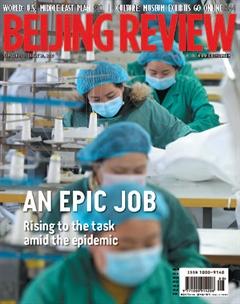HEAD IN THE CLOUD
By Li Fangfang


When the severe acute respiratory syndrome (SARS) virus struck 17 years ago, China was inching its way toward the information era. Alibaba was building the online shopping platform Taobao and developing its payment service Alipay, and the number of registered users of Tencents instant messaging service QQ had just exceeded 100 million.
“TV news programs were a major source of information for people like me to find out what was going on,” said Sunny Jiang to Pandaily.com about his experience in 2003. “My entire family freaked out when my dad got a fever, but we were too afraid to go to the hospital.” Luckily, his father only had the common flu.
Today, those startups from 2003 have grown into tech giants and have paved the way for the country to deal with national emergencies and make it possible for people to live an alternative life at home during the novel coronavirus outbreak.
Locked down but connected
Since the majority of Chinese people were encouraged to stay home as a precaution against contagion, the question of how to keep them informed and their daily life running has been answered by a modern, top-notch online infrastructure.
Now, people wake up every morning and can get information about the latest novel coronavirus cases from various channels on their phones or computers, such as newsfeeds, dashboards, news portals and text messages.
On January 23, Wuhan, the hardest-hit city in Hubei Province in central China, was put on lockdown, followed by several other cities. Four days later, the government extended the holiday and advised people to work from home, a measure which was seen as a way to contribute to the national fight against the virus.
Media and online platforms quickly responded to misleading rumors, which helped people realize how easily fake news can spread during an epidemic.
WeChat, Tencents popular multi-purpose app, became one of the main channels for residents to reach out for help. A mini-app on WeChat called Jiaozhen was launched on January 25 to help users filter out fake news, with expert explanations given for fast-spreading information that often proved to be false.
Practical ties
Thousands of WeChat groups have been established among communities, companies and non-governmental organizations, bridging the gap between people in need and people who can help.
Du Yun, a general practitioner in Wuhans Fangcao Community with over 5,000 residents, invited doctors and nurses who live in the community to join a WeChat group as a first step to address the epidemic.
“I suggested medical workers offer professional advice and psychological consultation for residents since the epidemic can easily cause panic,” Du said. “Having a fever doesnt necessarily mean one is carrying the novel coronavirus.”
The group has also turned into a logistics platform where community workers can buy daily necessities for residents who can then use a QR code to pay for them. Without ever having to meet face to face, social life continues.
Given that it is flu season in China, it is imperative to identify between a common respiratory illness and a viral pneumonia. This reassures people immediately and alleviates the burden of hospitals which may suffer shortages of medical personnel and materials.

But when community workers are unable to meet the needs of all who reach out, residents sometimes have to turn elsewhere for answers. As a result, many companies have launched online medical consultation services. On these platforms doctors or their artificial intelligence (AI) peers offer free advice.
Tencent launched a WeChat-based medical consultation platform for pneumonia-related questions for people with minor symptoms, partnering with five other popular online healthcare services including Dingxiang Yisheng and Haodf.com, which have recruited 10,000 licensed doctors from all over the country. Alibaba and Baidu are offering similar services.
As of January 30, the number of visits to Alibabas free consultation program offered on Taobao and Alipay had reached 2.8 million, with 90 percent coming from Wuhan. More than 530,000 consultations had been answered on a platform initiated by the smartphone app Chunyu Yisheng as of February 1, according to Jiemian.com, a news portal owned by the Shanghai United Media Group.

In addition, many other online-to-offline services have taken up their social responsibility. Ride-hailing services are playing a role as volunteer drivers help transport people to hospitals in areas where public transportation has been suspended. The on-demand service Meituan Waimais distribution channels have become the only way for many small restaurants to purchase materials, and the company has promised to guarantee catering services for frontline medical workers and senior nursing homes.
NetEase is providing classes for primary school students in Hubei, while ByteDance is inviting physicians to talk about novel coronavirus-related issues and safety measures on its popular mobile platforms Toutiao and Douyin(TikTok).
The cybersecurity solution provider Qihoo 360 has launched a system of reporting and statistics-gathering for community-based prevention and control. It identifies residents or visitors to a community and records their body temperature, which helps community workers collect real-time epidemic data that they then can report to local governments in a unified format.
For the public good
Since the novel coronavirus outbreak, at least 60 tech companies have rushed to provide support in various forms, according to data by news portal iFeng.com.
Alibaba Cloud, currently the countrys largest cloud-computing service platform, announced on January 29 that it will make all its AI computing capabilities available for free to help scientific research into new medicines and vaccines for the virus.
Baidu has made its computing and software for RNA structure prediction available to gene testing organizations and scientific research institutions all over the world.
Tencent Cloud, another leading cloud provider in the country, has given a research team at Sun Yat-sen University in Guangzhou, Guangdong Province in south China, free access to its cloud server and provided computing power and object storage capacity for a research team at Tsinghua University to help them conduct offline computing tasks for gene measurement.
Tencent has also become a reliable channel for crowdfunding. The company is cooperat- ing with public charity foundations seeking to raise money for specific projects by publicizing them on WeChat. Among the many projects to support Wuhan, the one to donate to medical workers who are vulnerable on the frontline tops the list.
For Zong Ning, an Internet content provider who lived through both the SARS epidemic in 2003 and todays novel coronavirus, the big difference is the participation of tech companies.
“This years fight against the novel coronavirus is tech-rich. More tech companies are participating in the battle. Their distribution channels, which were invisible to the general public, have become a lifeline,” Zong said.
“The infrastructure that facilitates entertainment services has become a strong support during a national emergency. It is worth thinking about how the whole tech industry can continue to fulfill its social responsibility after the epidemic,” Zong said. “Many tech products are actively functioning to keep society working.”

